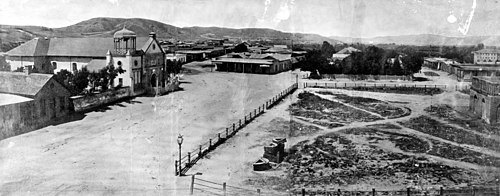Post-WWI Era (1920s-30s)
Post-World War I fear of communism manifested itself in Los Angeles through an increased nationalistic, anti-immigrant sentiment that would be expressed in education programs aimed at Mexican Americans, as well as urban development aimed at removing Mexican identity. While prominent politicians such as former governor Hiram Johnson and activist Simon Lubin advocated for progressive policies, such as women's rights and labor rights, local politics of Los Angeles county and California at large leaned conservative, with governor Friend W. Richardson reallocating the Americanization programs to the California Department of Education in 1923. The goal of these Americanization programs was to assimilate immigrants into "the American way of life" [7] and particularly targeted Mexican immigrants because of their perceived ethnic proximity to Europeans relative to other immigrant groups, such as the Chinese and Japanese; the main way this was achieved was through the instruction of the English language. At first, these programs prioritized Mexican men, registering them through their workplaces, but because of the seasonal nature of farm work, teaching English successfully was not possible. [7]
Aligning with the American ideal of Republican motherhood, assimilation efforts were eventually redirected toward Mexican women, who were usually in charge of the home and more involved in community institutions like schools than Mexican men. The new goal of Americanization programs then became training Mexican women for domestic work, to help "alleviate the shortage of housemaids, seamstresses, laundresses, and service workers." [7] By making Mexican women, the homemakers, more American, Americanists hoped that Mexican culture would slowly phase out of immigrants' lives; for example, replacing tortillas with bread during meals. These efforts to push Mexican women into newly-profitable, domestic work outside of the home was met with resistance, which Americanists attributed to machismo in Mexican culture. When naturalization rates of Mexican immigrants did not improve, Americanization programs shifted focus yet again to the implementation of Americanization curriculum in schools, in an effort to teach American values to American-born children of Mexican immigrants. Despite these programs promising full integration into American society, they only provided "idealized versions of American values" [7] and second-class citizenship, as Mexican immigrants continued to face economic disenfranchisement and their children received an unequal education to their white counterparts. [7]
Urban development efforts in Los Angeles, as well as the greater California region, were also influenced by the rising anti-immigrant sentiment as according to Phoebe S. Kropp. According to Kropp, Los Angeles engaged in construction projects to "reenvisioned the region’s nineteenth-century Spanish and Mexican history." The historical landmark Olvera Street is an example of these efforts, as "Olvera Street was 'A Mexican Street of Yesterday in a City of Today.'" [8]
All of these sentiments, along other factors, would eventually result in the Repatriation efforts from the Federal Government following the Stock Market Crash of 1929. During this time, many Mexicans and Mexican American citizens were deported or self-deported to Mexico. In Los Angeles and the Los Angeles county area, social programs and agencies provided bus and train tickets to Mexico. Deportation raids were a common occurrence in Los Angeles, including one raid on Olvera Street. [9]
WWII Era (1940s)
Agricultural labor shortages associated with World War II brought on another wave of Mexican immigration to Los Angeles. The bracero program, or guest worker program, was a partnership between the US and Mexican governments, as well as American farms, to bring Mexican agricultural workers to the United States through labor contracts. With a demand for workers that exceeded the supply of labor contracts, the bracero program inadvertently became one of the origins of undocumented immigration from Mexico to the United States. [10]
In urban areas of California, including Los Angeles, racial tensions were heightened as a result to changing urban developments and land seizures. In 1940, part of Chavez Ravine was seized to build a naval training school, and, according to Eduardo Pagan, disrupted communities and stood more as an "outpost standing watch over the surrounding enclaves of the local population." [11] These tensions increased as servicemen would leave the outpost and venture into the city "transgressing the unspoken mores of the predominantly Mexican, African American, Italian, and Jewish neighborhoods that lined the downtown district." [11] All of these resulted in several occurrences of violence known as the Zoot Suits Riot. The Zoot Suit Riots were a series of violent attacks between law enforcement, US servicemen and the Hispanic community, primarily Mexican men and teenagers. According to Pagan, these series of attacks can be seen as a struggle between a community and an occupying entity as much as they are gendered tensions between the need from all sides needing to present masculinity for the public during heated moments of conflict. [11]



